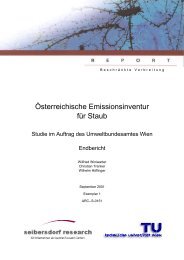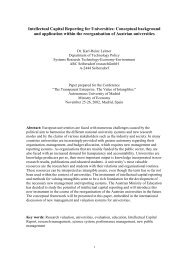ALPMON FINAL REPORT - ARC systems research
ALPMON FINAL REPORT - ARC systems research
ALPMON FINAL REPORT - ARC systems research
You also want an ePaper? Increase the reach of your titles
YUMPU automatically turns print PDFs into web optimized ePapers that Google loves.
Contract ENV4-CT96-0359 <strong>ALPMON</strong><br />
Through producing virtual landscape photographs and 'fly throughs' remote sensing data can be used<br />
for publicity purposes. They provide a very good impression of the landscape and, together with a<br />
digital elevation model, the morphology.<br />
However, the remote sensing data can also be used very well as background for hiking maps and<br />
other thematic maps. Satellite images increase the attractiveness of these maps and, with a suitable<br />
print quality, can at the same time represent the various structures of the landscape. For the Forest<br />
Administration analogue maps were printed which show the fusion image as background. As additional<br />
information, the streets, trails and the place names were added. A survey map of scale 1:50 000 and a<br />
more detailed map of scale 1:25 000 have been made.<br />
2.3.1.3.3 Task: land cover<br />
A description of the present land cover was required by both customers: the Tourist and the Forest<br />
Administration at Tarvisio.<br />
The satellite image classification has already been described in detail (reports to work packages 9 and<br />
10). The customers were satisfied by the results of the classification. Though there have been some<br />
lacks: the shaded areas could not be classified; sealed surface could not be separated from rock.<br />
However the classification results show a good view of the present situation in the test site.<br />
2.3.1.3.4 Task: Monitoring of forest /open land - example: alpine pastures<br />
For landscape related tourism, open areas are very important. They liven up the forest areas, they give<br />
the possibility to rest on blooming meadows and last but not least they give the chance to admire the<br />
panorama. However, natural open areas only occur in high areas (alpine meadows). Below the timber<br />
line, nearly all open areas were made through agricultural use and therefore build a man-made<br />
landscape. The difficult situation of agriculture in the Alps resulted again and again in areas that are<br />
given up. The result of giving up these areas is the recovery of forest.<br />
In order to see, whether modifications occurred in the last decades, the fusion image of 1992 is<br />
compared with black and white aerial photos of 1954. In this way a period of four decades could be<br />
investigated. As an example the evolution of the alpine pastures were chosen. This example interested<br />
all of our customers: the Forest Administration at Tarvisio (concerning the increase of forest) and the<br />
Tourism Administration (concerning the loss of open land). In addition the Comunità Montana at<br />
Pontebba was very much interested in the changes of the alpine pastures.<br />
Three different classes were measured: pasture, succession and forest. The succession and forest<br />
areas have to have at least 0.1 hectare. Areas with 10 to 30% of tree stocking were defined as<br />
succession. Forest is defined as area which are at least 30% covered by trees. Within succession and<br />
forest there areas without stocking were delineated if this area has at least a size of 0.1 hectare.<br />
Result:<br />
In fact there occurred a clear landscape modification in the last 40 years. Almost on all alpine pastures,<br />
a clear increase of forest could be observed. An increase of pasture did nearly not occur. Only on<br />
single plots there is an expansion of the pasture. A good example is the alpine pasture "Goriane". The<br />
increase of forest is clearly to be seen. In the northern part there is a slight increase of the pasture to<br />
the east and west: an exception as mentioned before.<br />
In total the pasture has lost approximately 170 hectares. That corresponds to 35.5% of the pasture<br />
area of 1954. The entire area of successions only increased insignificantly. It is to be found on about<br />
65 hectares 1992 and on 62 hectares in 1954. That means the decrease of the pasture area has<br />
almost gone completely for the benefit of the forest.<br />
The ortho-rectification of the aerial photos would have been more precise if the original photos could<br />
have been used. Using a specific scanner would minimise the distortion. However, it is considerably<br />
more economic to use normal scanners. For the aim 'monitoring of landscape modifications', this lowcost<br />
method is sufficient since no highly precise measurements are necessary. The problem of the<br />
missing camera calibration and the lack of older topographical maps for getting control points has been<br />
considerably more seriously. Due to the inaccuracies, clear differences have to be proved in order to<br />
be able to talk about landscape modification. Therefore, all information was only given in hectares.<br />
More precise statements are not possible on the basis of the available data. However, the landscape<br />
modifications are engraving in the last 40 years. This could be clearly proved in spite of the not optimal<br />
data basis.<br />
JR, RSDE, ALU, LMU, Seibersdorf, WSL 29




